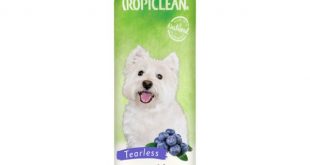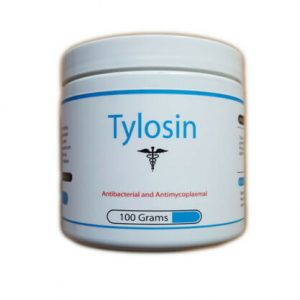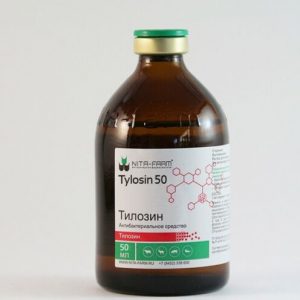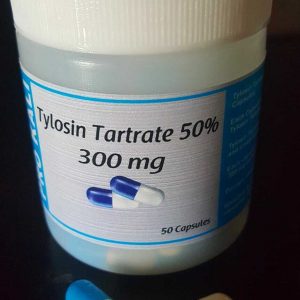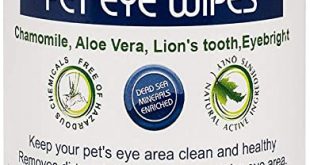In 1928 Alexander Fleming shook the world with the first antibiotic, penicillin. Approximately 50 years later there was a new and powerful antibiotic. This antibiotic is known as Tylosin. It is for internal infections of a wide variety from farm animals to house pets. It can also be used to treat Tear Stains in dogs. Tylosin works by promoting the growth of beneficial bacteria while stagnating harmful ones. This is done to cure the infection and keep the immune system strong thus the reason for stagnating and not eliminating the infection. Due to Tylosin being an antibiotic, veterinarians and farmers have to be careful with its use. Antibiotics can cause more harm than good if not used for the right treatment.
-
 Tylosin Soluble Powder 100 gramsOriginal price was: $72.00.$65.00Current price is: $65.00.
Tylosin Soluble Powder 100 gramsOriginal price was: $72.00.$65.00Current price is: $65.00. -
 Tylosin 50 Injectable AntibioticOriginal price was: $65.00.$58.00Current price is: $58.00.
Tylosin 50 Injectable AntibioticOriginal price was: $65.00.$58.00Current price is: $58.00. -
 Tylosin 25 mg per Capsules Soluble PowderOriginal price was: $95.00.$89.00Current price is: $89.00.
Tylosin 25 mg per Capsules Soluble PowderOriginal price was: $95.00.$89.00Current price is: $89.00.
Tylosin is used for many respiratory diseases, mastitis, dysentery, and other medical complications. It comes in powder, injectable, oral liquid, and pill form. This is prescribed mainly to dogs, cats, chickens, cows, pigs, and more Tylosin in its powdered form is recommended for Tear Stain treatment in dogs.
Tylosin for Dog and Cats and Dosage Recommendations

A man’s best friend (dogs) and a pet worshiped by Egyptians (cats) don’t deserve to have a bowel infection. No one wants to pick up chronic diarrhea or deal with a gross litter box. This disease can cause major problems for your pet in the future. So, what’s the solution? Tylosin, as it has been used as an antibiotic since its invention in the early 70s. For both dogs and cats, the recommended dosage is 6.8 mg/lb. orally twice a day. If the pet is small it will be administered through a needle and should be done by a veterinarian. It also comes in pill form. The pill should be mixed with food as it has a bitter taste. For dogs try peanut butter (check for xylitol as it has an artificial sweetener that’s poisonous for dogs!) and try tuna for cats. Anything you can mush together typically works but these are the top recommendations for each pet.
Dosage for Tear Stains in Dogs
Dosage guidelines or dogs for Tear Stain removal are as follows:
- 13kg/30 lb – 1/8 tsp
- 27kg/60 lb – 1/4 tsp
- 41kg/90 lb – 3/8 tsp
- 54kg/120 lb – 1/2 tsp
- Tylosin powder should be administered twice per day.
Please see the table below for dosage guidelines for Tear Stains in dogs.
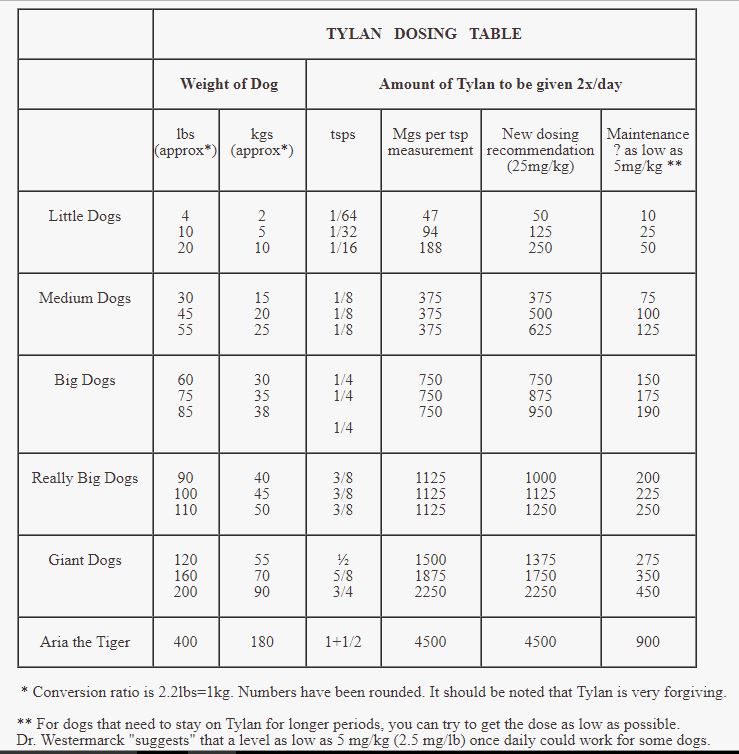
Colitis
This bowel infection is defined as colitis which is the cause for dysentery (chronic diarrhea). It typically takes three days for the antibiotic to cure colitis. But that’s not all Tylosin can do. It is even used to cure severe tear production known as epiphora. It reduces the tear ducts ability to cry. In most cases due to an insufficient tear film (holds tears within the eye better). Do not cross Tylosin with erythromycin. This is because Tylosin increases digoxin blood levels and if your dog/cat is administered erythromycin (also increases blood levels) it can do more harm than good. This could cause further infection problems so be sure to ask your veterinarian. If it is not solved through Tylosin, the veterinarian will likely check for red and white blood cells for any parasites. The problem could be whipworm, this is common in dogs and cats. Whipworms are more difficult to detect than most diseases.
Deworming
There would be a deworming process through multiple medications that won’t take too long for your pet to overcome. You can prevent colitis in the future by giving your dog/cat a high fiber diet. It is also important to feed your dog or cat lots of water. Keep them away from non-food materials like grass, fabric, and table-top scrap bones. Stop feeding animals from the table as many human foods are poisonous to pets other than chocolate. For example, raisins, macadamia nuts, garlic, and avocados are poisonous to dogs/cats. Don’t worry because in most cases, the diagnosis for colitis will lead to an antibiotic like Tylosin. Tylosin is a savior to a pet lover’s time for buying more poop bags or kitty litter.
Tylosin for Chickens Treatment and Dosage Recommendations
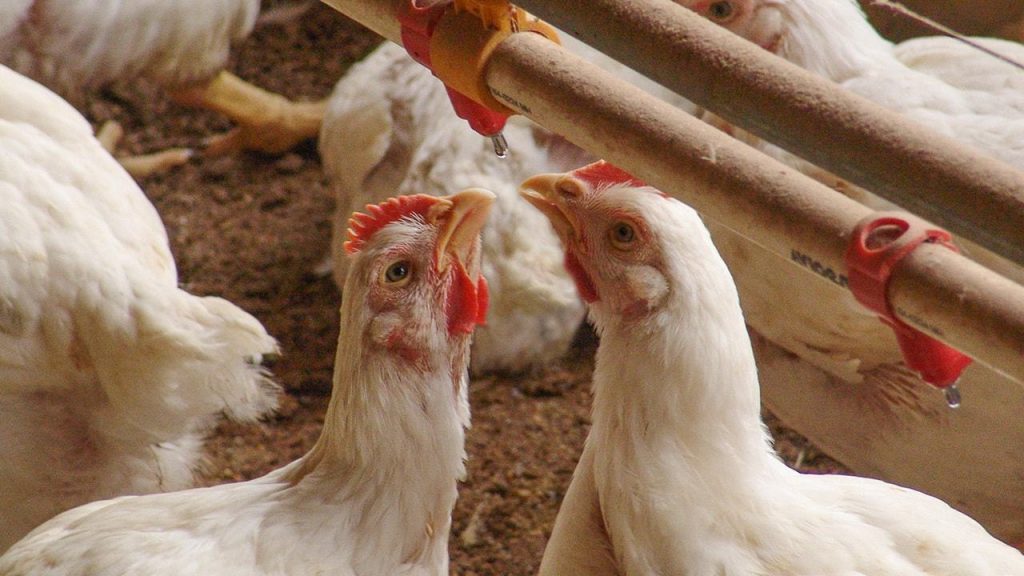
“Gobble gobble,” Chicken Little is in trouble but the sky isn’t falling. Tylosin can be used to cure many problems for chickens.
Dosage
The dosages vary depending on how it is medically administered. If you were to use a needle 6.8-13.6mg/lb. every 8-12h, orally 22.6mg/lb. once daily, and if added to drinking water 50mg/L. A common powder form of Tylosin is a brand known as Tylan. Firstly, Tylan can be used to cure conjunctivitis (pink eye) when mixed with water and sprayed. This is used by mixing sterile water (mixed 1:10) with a regular spray bottle.
Treatment for Conjunctivitis
This could just be pink eye or a result of a bigger disease known as mycoplasma gallisepticum (mentioned further below). Secondly, Farmers also use Tylan to cure necrotic enteritis; this is an intestinal infection that causes a sharp increase in death rates. The two main symptoms are dehydration and the skin becomes sticky, clinging to the chicken’s muscles. The mass number of lesions should also be noted within the intestinal tract.
The chicken could die due to multiple hemorrhages within the intestines. Thirdly, it can be used to cure a chronic respiratory disease known as mycoplasma gallisepticum found in poultry. This disease hurts the chicken’s airways and causes major issues that could lead to death. Other symptoms include coughing, sneezing, nasal discharge, and foamy eyes. There is considerable strain variability, which means wider spread due to host susceptibility, virulence, and immunologic response.
Treatment for Mycoplasma Synoviae
Lastly, Tylosin cures mycoplasma synoviae, this is a similar respiratory disease (mycoplasma gallisepticum) that is less lethal and may affect eggshells to create thinner layers. Although, this disease strain can become a systemic one (a more potent strain than the subclinical disease) and can cause bursitis in joints/tendons. Bursitis creates fluid-filled sacs that start between bones, tendons, and joints. It can cause severe pain, loss of movement and stress in poultry livestock.
Mycoplasma synoviae can also cause septicaemia which is a life-threatening infection due to a large number of bacteria in the bloodstream. This is referred to as blood poisoning. Both mycoplasma diseases are contagious due to wild birds and with so many poultry farms in rural areas, it makes Tylosin that much more important. That’s why wild birds are given Tylosin in feeders to prevent further contamination. Although this disease is not contagious to human’s health regulations are thorough. All infected animals that are uncurable cannot be sold for their produce and must be incinerated or buried. This is a precaution to prevent new viral strains from affecting humans.
An example of a dangerous strain is bird flu. Bird flu arose in 1997 and killed 60 percent of all who were infected. It spread from aquatic birds like ducks in Hong Kong. A more virulent strain spread to the poultry industry. Factory farms in Hong Kong were perfect for the virus as the farms were in a tightly crowded enclosed environment. The virus spread through corpses eaten or through secretion. Luckily human to human contact does not spread the disease further, which is why the global death count is approximately 1,500. This is why European and North American practices are more cautious of curing or preventing infected animals from harming us. This includes open-area farms or at least more space, better cleanliness, and improved cooking practices for poultry. Hopefully, this will make people strive towards better farming conditions to protect our health, especially in populous areas.
Safe for Poultry Laying Eggs
There are other benefits to Tylosin as the brand Tylan has a 0-day egg withdrawal period. Meaning that Tylan is approved for use in laying poultry eggs right away however this has to be in accordance with the product manufacturer’s label directions (some may differ slightly in withdrawal period depending on manufacturer and location). For health precautions, chickens may not be slaughtered until 24-hours has passed since administered. A farmer can now safely count their chickens before they hatch with Tylosin.
Tylosin for Cattle, Treatment and Dosage Recommendations
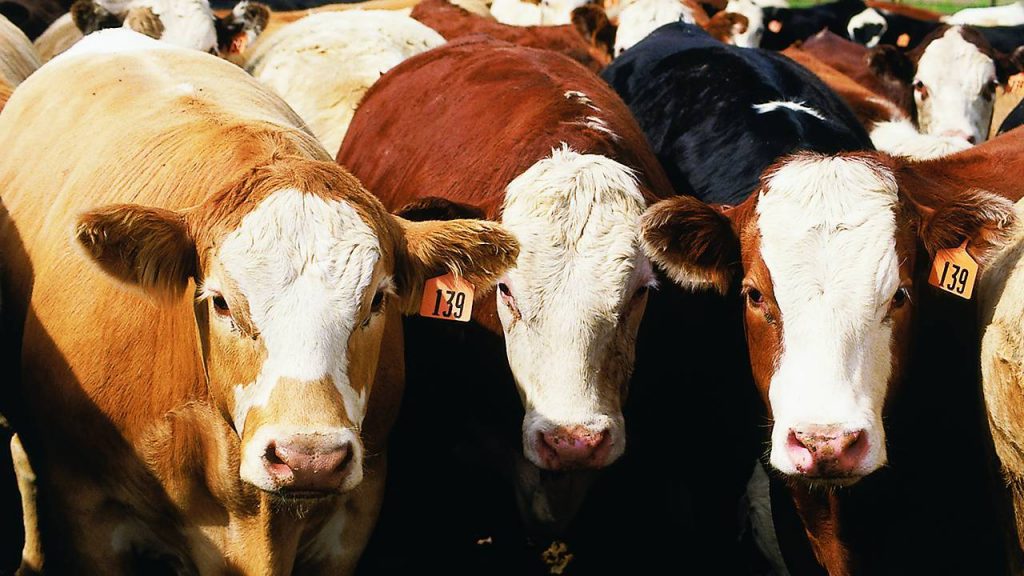
“Moooooving,” on to the next animal that can benefit from Tylosin are cows. A famous brand Tylan (mentioned before) has been trusted by farmers for over 30 years due to their reliability.
Dosage
Dosages are 8mg/lb. one-time delay injection. Do not inject more than 10mL per site and do not exceed 5 days in dosage. This has a wide range of uses for medical complications in cattle. The first being pneumonia which is an inflammation of air sacs in the lungs.
Common Diseases in Cattle Tylosin Can be used to Treat
Pneumonia
Pneumonia can be lethal and should be treated immediately. The second is foot rot. This is an infection that causes inflammation between the hooves resulting in lameness (lying down on its side instead of standing). Lameness causes muscle dystrophy, loss of fertility, and a shorter lifespan. That is why foot rot is detrimental to farm economics.
Diphtheria
Another aspect Tylosin cures is calf diphtheria which is an infection of the vocal fold. This infection restricts airways and, in some cases, can progress to be lethal to the calf. The third disease Tylosin cures is metritis. This is an inflammation of the uterus often seen after calving with complications during birth (stillborns, twins, dystocia ect,
Metritis
Metritis hurts a farmer’s ability to produce cattle as this creates poor reproductive performance and lower conception rates. The final disease Tylosin cures is liver abscesses, which up to a third of cows get from feedlots. This happens due to high-energy grains fed to cows to fatten them up before slaughter. The grains can ferment quickly, creating bacterial acid that damages stomach lining. This bacteria spreads to the bloodstream, then to the liver, where the lesions form. This is likely due to the body being unable to process certain products in the grain/corn mix. Grass-fed cows are less likely to suffer from such problems. However, this costs more and is not as beneficial economically for the industry. The pressure to mass-produce meat cheaper and more efficient makes Tylosin a necessity. Cattle intended for human consumption must have a 21-withdrawal period before slaughter. For those reasons, Tylosin is a highly recommended drug for cattle farmers.
Tylosin for Pigs Treatment and Dosage Recommendations
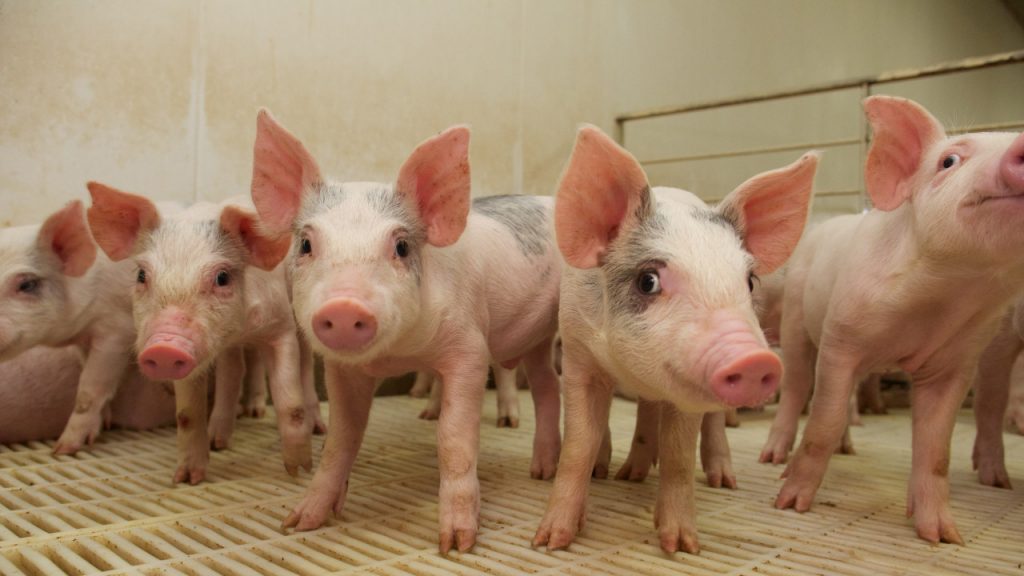
“Th-Th-The, Th-Th-The, Th-Th… That’s not all, folks!” Tylosin is used for treating several diseases in pigs.
Dosage
Typical injection is for Tylan 200 (Tylosin brand) is 4mg/lb. twice daily. Treatment should continue until signs of remission, do not keep injecting past 3 days or inject more than 5mL per site. This is used to treat many medical problems.
Swine Arthritis
The first is swine arthritis which is the inflammation of joints. This is common for growing pigs. Lameness is a side effect and can even cause death in piglets. The second is dysentery, this is an easier problem to fix. By giving the recommended dosage, cycling clean water more often, and keeping the food fresh the pig will recover. However, if the dysentery is from the disease ileitis it will be slightly more difficult. This causes mucus to build up in the intestinal wall that can lead to lesions and eventually death. The third is swine erysipelas which is characterized by enlarged joints and lameness.
This is contagious through secretion. Another strain of swine erysipelas causes respiratory distress due to valvular endocarditis (blood cells lodged in damaged heart or arteries). Both diseases have skin lesions, painful joints, and can result in death.
Finally, Tylosin can be used for swine pneumonia, this is an inflammation in the air sacks of the lungs. A regular problem in growing piglets. If the pneumonia-like pathogen is new and left untreated it will have a death rate of 12%. The scariest example would be swine flu and is extremely contagious. The withdrawal period for slaughter is 9 days after the last treatment (varies on the type of Tylosin medicine and dosage). If porky pig gets sick, he can be at ease with Tylosin.
Swine Flu
One of the leading viral strain concerns is swine flu (H1N1 virus). The world health organization (WHO) declared it a pandemic. The 2010 swine flu shot has developed each year to prevent further viral changes that could be detrimental. The cause of swine flu is through eating uncooked pork. It can also spread through a cough or a sneeze of someone who has the disease. Although the new disease scared people in 2009, studies show that in most cases swine flu isn’t lethal. Furthermore, proper vaccination was discovered a year later in 2010. The total death toll was more popular in less developed countries, this is why the total global count is extremely approximate from 151,000 to 575,000. The regular flu death toll is 646,000 every year. If you get modern-day vaccinations each year, buy from companies with smart farming practices, use proper cooking techniques, and have a healthy body you should have nothing to worry about.
For Honey Bees
So, is that all the uses for Tylosin? Nope, there are many other examples. In honey bees, it is used for curing American foulbrood, especially in larvae. This is a fatal disease for honey bees that create spores all around the beehive and is highly contagious. Tylosin is also used for weight gain for chicken, cattle, and pigs. Tylosin can be used for ferrets, rabbits, birds, sheep, goats, and reptiles. For pets, it is most commonly used for dysentery. There are some animals that cannot take this drug. For example, Tylosin can be fatal to horses and other equines.
Can Tylosin be used for Humans
Now has Tylosin been used on humans? There were tests conducted in 1968 (2 years before the release) on the effects the drug has on the human body. Both showed no changes based on small 5mg dosages for 6 months under close surveillance. They concluded that there were no risks for humans at a microbiological level. While this isn’t used for any human illnesses it is safe to know that the farmers and pet lovers who administer Tylosin are not at risk.
Antibiotics in Food
Time to address the general concern of antibiotics in food. Antibiotics are regulated for Canadian farmers for growth and are administered if necessary, to keep the livestock healthy. In December 2018 farmers need a prescription to obtain veterinary grade antibiotics. The federal government has set tougher food standards. This is also the reason farmers have to adhere to the withdrawal period before slaughter so the antibiotics are out of their digestive system. This reduction is necessary for antimicrobial resistance. In other words, a controlled amount of antibiotics will reduce harmful bacterial resistance. Antibiotics are a huge contribution to the economy with the selection of cheaper meat being mass-produced. There are options for those who disagree with such methods in grocery stores.
Side Effects of Tylosin
Does Tylosin have any side effects? There are some, one of them is a stomach ache after first receiving Tylosin. This is why it is recommended to feed the pet with the pill to prevent stomach irritability. Another is the initial worsening of diarrhea. This happens because the antibodies are fighting off the bacteria in the intestine/colon. The body attacks the bad bacteria and quickly gets rid of it through feces. Tylosin should be used with extreme caution on pregnant or lactating pets. The concern is the antibiotic going to the fetus or offspring through breast milk. Due to the drug being second hand, in smaller dosages, the pet will be cured. Although, smaller dosages may take longer to cure any infection that is causing dysentery. It is common for pets to drink a lot more water due to the body flushing out the bad bacteria. Other side effects include agitation, stress, and dry eyes. Most side effects subside in a few days but if they persist please contact your veterinarian.
Conclusion
In conclusion, antibiotics help many farmers keep their livestock from fatal diseases. It prolongs the food necessary that our massive population needs. The antibiotic Tylosin has a wide range of uses from helping your pet dog to saving an entire herd of animals from disease. That is why Tylosin has been a breakthrough in antibiotics.
 Total Pooch Dog Supplements, Tear Stain Removers, De-wormers, Tylosin for Dogs and other great products.
Total Pooch Dog Supplements, Tear Stain Removers, De-wormers, Tylosin for Dogs and other great products.

